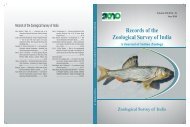Vol. 111 - Part I - Zoological Survey of India
Vol. 111 - Part I - Zoological Survey of India
Vol. 111 - Part I - Zoological Survey of India
You also want an ePaper? Increase the reach of your titles
YUMPU automatically turns print PDFs into web optimized ePapers that Google loves.
86 Rec. zool. Surv. <strong>India</strong><br />
slightly depressed in middle posteriorly with a tumid<br />
elevation above the base <strong>of</strong> forceps. Male forceps with<br />
the branches remote at the base, slender and elongate,<br />
bowed so as to form an elliptical space up to its two<br />
thirds part <strong>of</strong> their length from where the apical one<br />
third is straight downwards with pointed hooks inwards.<br />
Genitalia with parameres about five times longer than<br />
broad, almost <strong>of</strong> uniform width and rounded apex with<br />
short epimerite.<br />
Distribution : <strong>India</strong> : Sikkim, Uttarakhand, West<br />
Bengal, Tamil Nadu, Kerala and Uttar Pradesh (Jhansi<br />
district).<br />
Proreus abdominalis Ramamurthi, 1965<br />
1965. Proreus abdominalis Ramamurthi, Ann. Mag. nat.<br />
Hist., 8(13) : 61, figs. 8-10 (♂♀ <strong>India</strong> : Tamil Nadu).<br />
1976. P. simulans abdominalis, Srivastava, Rec. zool. Surv.<br />
<strong>India</strong> Occ. Paper, 2 : 50.<br />
1987. P. abdominalis Steinmann, Annls. Hist. nat. Mus. natn.<br />
Hung., 79 : 117.<br />
Material examined : <strong>India</strong> : Uttar Pradesh: Deoria<br />
district, Khukhundu village, 1♂ in crevices <strong>of</strong> walls,<br />
1♀, attracted at light, 17.VIII.2007, Coll : V.D. Hegde<br />
and <strong>Part</strong>y.<br />
Diagnostic characters : Head orange or almond<br />
coloured; antennae 22 segmented, 1st club shaped,<br />
longer than the combined length <strong>of</strong> 2nd & 3rd , 2nd small<br />
and cuboidal, 3rd , 4th and 5th cylindrical, slightly longer<br />
than broad, 6th and onwards gradually elongated and<br />
subcylindrical; mesotarsus bearing a spiniform obtuse<br />
process visible in a lateral view under 3rd tarsal joint.<br />
Eyes small but prominent. Pronotum longer than broad,<br />
prozona with almond or light brown colour, metazona<br />
fuscus, sides pale yellow. Elytra and wings well<br />
developed, yellowish with light blackish brown bands.<br />
Abdominal tergites punctuate with scarce pubescence;<br />
ultimate tergite quadrate, broader than long with disc<br />
Fig. : Genitalia <strong>of</strong> Proreus abdominalis<br />
terminating posteriorly in a row <strong>of</strong> 4 tubercles, caudal<br />
margin sinuate and raised above base <strong>of</strong> forceps.<br />
Forceps cylindrical, arcuate, so as to form an oval<br />
space, armed internally with a sharp tooth, a little<br />
behind middle <strong>of</strong> each arm ending in pointed hooks<br />
inwards. Genitalia is as shown in the figure.<br />
Distribution : <strong>India</strong> : Karnataka, Orissa and Uttar<br />
Pradesh (Deoria district).<br />
ACKNOWLEDGEMENTS<br />
Sincere thanks are due to Principal Chief<br />
Conservator <strong>of</strong> Forests and Wildlife Warden, Uttar<br />
Pradesh State for the permission to collect the specimen<br />
and all the Forest Officials specially to Shri. Ganesh<br />
Bhat. D.F.O. for his valuable suggestion during our<br />
survey. We are also thankful to Dr. G.K. Srivastava,<br />
Retd. Scientist, ZSI for his valuable suggestion during<br />
the preparation <strong>of</strong> the manuscript. We are very much<br />
indebted to the Director, <strong>Zoological</strong> <strong>Survey</strong> <strong>of</strong> <strong>India</strong> for<br />
facilities and all other staffs <strong>of</strong> Coleoptera for<br />
encouragement.<br />
REFERENCES<br />
Srivastava, G.K. 1988. Fauna <strong>of</strong> <strong>India</strong> Dermaptera (<strong>Part</strong>-1), Superfamily : Pygidicranoidea. Pp. I – xii+ 1-268, Calcutta<br />
(<strong>Zoological</strong> <strong>Survey</strong> <strong>of</strong> <strong>India</strong>).<br />
Srivastava, G.K. 1989 Fauna <strong>of</strong> Orissa : State Fauna Series No. 1 p : 147-170.<br />
Srivastava, G.K. 2003. Fauna <strong>of</strong> <strong>India</strong> and the adjacent countries, Dermaptera (<strong>Part</strong>-2), (Super family : Anisolaboidea.)<br />
1-235 Published by the Director, <strong>Zoological</strong> <strong>Survey</strong> <strong>of</strong> <strong>India</strong>, Kolkata.<br />
V.D. HEGDE* AND B. LAL<br />
<strong>Zoological</strong> <strong>Survey</strong> <strong>of</strong> <strong>India</strong>, M-Block,<br />
New Alipore<br />
Kolkata-700053<br />
*Corresponding author : E-mail_hegde 67@yahoo.co.in
















